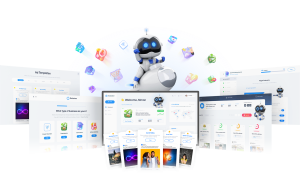Do you struggle to come up with great headlines that will attract your ideal readers and compel them to click on your content? Are you tired of seeing your posts get buried in search results without getting the visibility they deserve? If so, you’re not alone. Many marketers and digital agencies are struggling too. Alas, there isn’t an algorithmic answer as to why some high-quality content is difficult to rank while others leap off the front page like little puppies eager for a treat. However, we can all do our part by optimizing every headline in order to achieve the best possible results.
In this blog post, we will cover what you need to know about optimizing your Amp campaign headlines for better rankings and visibility. We will explore what headlining elements you need to have in place, and some simple tips and tricks you can implement today to start seeing results with your content marketing efforts.
Do Your Own Keyword Research
Keyword research is a crucial first step in your content marketing strategy. Don’t skip this step if you want to generate some good headline ideas! Your goal should be to find the right words, phrases and questions people are using when searching for your products or services. You can then use those keywords as a guide to create relevant content that will help your audience solve their problems and achieve their goals.
Doing your own research helps you identify what types of headlines work, but it’s also essential to find out what your target audience wants and needs. The content you create should address their pain points, answer questions they may have, and provide solutions for them in order for them to consider learning more about your brand and purchasing your product or service.
Abide By The Rules for Each Module
The news headline in particular is that it needs to adhere to fairly strict guidelines. A good rule of thumb is to make sure your headline is 80 characters or fewer, since Google will cut off any word that exceeds this limit.
When writing a news story, keep in mind that most people are only going to read the first paragraph or so—so make sure it’s attention-grabbing! You also want to include a newsworthy angle: what’s different about this piece? How does it connect with other pieces of information out there? What makes it interesting enough for readers’ eyes?
Use Long-Tail Keywords
While it’s possible to get creative with your headlines, long tail keywords remain the best way to optimize your headlines across all modules of your Amp campaign. Longer keywords are more specific and targeted, which means they’re less competitive. More importantly, they make it easier for searchers to find what they’re looking for on Google.
For example, consider using keyword phrases like “expert practices for driving traffic from social media” instead of just “driving traffic from social media.” If you’re selling a product or service that can help people drive more traffic from social media platforms like Facebook, Twitter and Instagram, use the phrase “expert practices for driving [product] traffic from [platform].” This will allow you target those who are specifically interested in these topics while avoiding competing against other companies promoting similar products or services through broad terms such as “social media marketing.”
Place Your Main Keywords At The Beginning Of The Headline
This is one of the best writing practices for optimizing your titles for both search engine results pages (SERPs) and people.
Google’s algorithm gives more weight to words appearing closer to the beginning of the copy, so it’s essential that you place any core keyword (or combination of keywords) there to ensure high visibility and ranking.
This means that the more you optimize your headline so that it has a higher keyword density and contains keywords relevant to your industry, niche, geographic location and target audience, the better you will rank in Google and the more website visitors you will attract.
Use Niche Specific Keywords
Using industry and niche-specific keywords will help you rank higher on search engines and attract readers. These are the keywords that people who are interested in a certain topic will use in their search queries.
For example: if you’re writing about how to make roasted chicken with potatoes, you can use “roasted chicken” as your keyword. But if you add the word “roasted” before the actual recipe title, it will be more visible for people searching for recipes with roast chicken. This is because Google considers this variation of your title as more relevant than others (as it’s less generic) and promotes it further down on its search results pages.
Focus On A Specific Audience
You know the old saying, “Don’t put all your eggs in one basket”? Well, when it comes to content marketing campaigns and rankings on Google, that’s precisely what you’re doing if you don’t think about your target audience.
The best way to optimize your headlines is by writing for a specific audience with the right keywords. When you write content that speaks directly to a highly targeted audience and includes their language, Google will be able to better understand exactly what those readers want in order for them not only find your articles but also engage with them so much more than they would otherwise have done before reading anything from another source.
Creating Secondary Strong Headlines Begins With Your News Article
Use the same keywords in the headline and body copy when repurposing content pieces. When you have an article that’s taken off, consider reworking it into the other Amp modules: into your podcast episode or video, or perhaps even into your slideshows to post on Slideshare. You can even tweak your long-tail keywords to create an alternative headline for your infographic using the same concepts as your original headline! Having consistency between the different modules will help Google understand what each piece is about and help you further build your brand’s exposure.
By changing the phrasing around the service, the location and the target audience, you can make subtle but powerful secondary headlines. This is a simple yet effective strategy that will help you boost your content ranking, reach out to new audiences and increase your search visibility.
If you are still unsure about your headline, here are some questions to consider:
- Can I place the main keyword closer to the start without affecting readability?
- Am I maximizing space by keeping non-keywords to a minimum?
- Can I remove some non-keywords without making the headline clunky?
Remember you don’t want to get arty with your headlines. You want to be practical. If you want to stand the best chance of success by using these tips you’ll be improving your ranking and visibility in no time.
Headlines are important because they help people to find your content. Since headlines appear on search engine results pages, they’re the first thing readers see before deciding whether or not they want to read more of your brand.
Are you looking for help to optimize and optimize your content marketing campaign headlines? Book a free call to speak with our team of writing experts that can help you secure top ranking positions on search engines and achieve the best ROI.
Author
-
CEO and Co-Founder at AmpiFire. Book a call with the team by clicking the link below.
Related Posts

How To Optimize Your Blog Post Headlines To Boost Your Online Visibility & Audience Engagement?
If you're looking to boost your blog's visibility, engagement, and audience engagement, optimizing your blog post headlines is a great…

The 6-Levels Headline Approach For Effective Keyword Selection | How to Create Killer News Article Headlines That Get Traffic & Build Your Brand
By completing all seven steps below, you should have enough keyword ideas to create one or more unique news headline…

6 Steps To Optimize Your YouTube Videos and 50x Your Traffic & Engagement? [Infographic]
Are you getting the most out of your YouTube videos? Follow these 6 steps to get more engagement, more traffic,…

Rocketeer Features & Pricing: Can This “Ads Made Easy” Software Drive Instant Traffic to Any Website?
Explore Rocketeer's features and pricing to see if this "ads made easy" software can drive instant traffic to your website…

Zero Traffic Keywords Have Huge Search Volume
Zero-traffic keywords have a hidden yet huge potential in content strategy. Discover why these overlooked terms can drive significant traffic…

How to Boost Your eCommerce Brand Exposure: 7 Strategies for Building & Marketing a Successful Online Store [Examples]
When it comes to building a successful eCommerce brand, visibility is key. Whether you sell premium goods or are simply…










